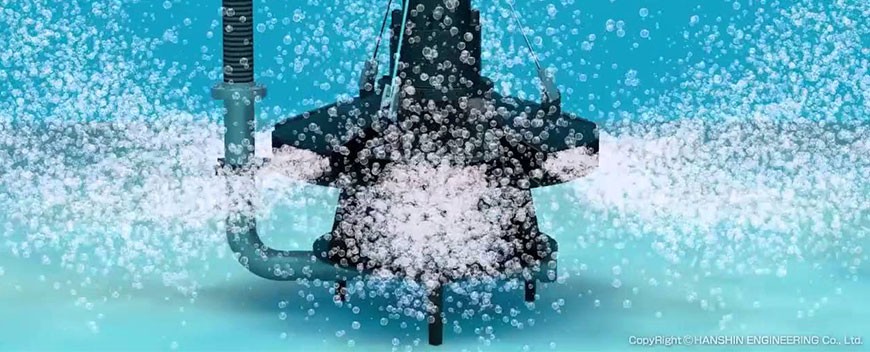
Aquarator
Since the invention of the world’s first, energy conserving aerating/agitatingequipment in 1975,Hanshin has continued to provide technological innovations to pioneer a new future for people and water. The Hanshin Aquarator is the embodiment of these ideas and technology at their highest levels. Aeration and agitation are the two major functions of the aerator. In order to provide superior performance in both these functions, it is critical that fine bubbles are generated and mixed with the liquid effectively to reach all areas of the aeration tank.
The Hanshin AQUARATOR provides robust agitation efficiency through its large pumping impeller driven at low speed at high torque. As well as directing the discharge flow obliquely down, the casing unit with our unique petal shape form prevents the occurrence of a Karman vortex. This ensures the liquid flows to all areas and the extreme periphery of the tank. In addition, the air dispersing rotor provides a shear force by rotation to the bubbles passing through this aperture to enhance bubble miniaturization. This type of AQUARATOR provides exceptional aeration and agitation performance through the improvement in the oxygen transfer coefficient from miniaturized bubbles generated at low speed and high agitation.
Conventionally, bioreactors used in wastewater treatment systems have used blowers to blow in air through diffuser pipes, diffuser tubes, diffusion plates or the like set in the aeration tank. Because this method uses a single source of power, and because large amounts of air must be constantly blown in to maintain agitation ability (to prevent the sludge from settling) even, for example, when the amount of water flowing in is extremely small, and because of inadequate functions to track responses to changes, there have been increasing calls for improvements in both the water treatment technology and water treatment costs.
AQUARATOR aeration system improves the functions needed for aeration by separating the power sources for the air supply function and the air diffusion function, and logically embodying the former function in a blower and the latter function in a AQUARATOR, thereby significantly improving the power efficiency in aeration (Ministry of Land, Infrastructure, Transport and Tourism Approval No. 81102). Separating the power sources enables AQUARATOR to function as a submerged agitator for both anaerobic and aerobic applications, and can be easily be optionally selected for standard methods, or for anaerobic or aerobic processes according to the method for sewage disposal. Being able to freely control the air supply (blower) and air diffusion (AQUARATOR) functions either individually or both together makes it a device capable of cutting waste in energy consumption, as well as dramatically reducing water treatment costs.
At present, the activated sludge method is the predominant process used for water treatment at sewage treatment plants and industrial wastewater treatment facilities, and this method is expected to continue to come into even wider use. Consequently, what will be increasingly important is the ease and economic efficiency of operation and maintenance. Easy operability and maintainability are strongly related to economic efficiency. In terms of water treatment technology, operation and maintenance can be summarized in the following three points: (1) Overcoming solid/liquid separation problems (bulking) resulting from filamentous fungi and actinomycetes etc. (2) Preventing deterioration in water quality as a result of nitrification and denitrification. (3) Preventing eutrophication from nutrients such as nitrogen and phosphorus. The above points can be eliminated or countered by being able to freely operate as anaerobic or aerobic conditions. This substantially decreases water treatment costs.
Source by: http://team-e-kansai.jp/wordpress/wp-content/uploads/hanshin1.pdf

